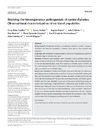Please use this identifier to cite or link to this item:
http://hdl.handle.net/10553/105839
| Title: | Studying the heterogeneous pathogenesis of canine diabetes: Observational characterization of an island population | Authors: | Brito Casillas, Yeray Melián Limiñana, Carlos Holder, Angela Wiebe ---,Julia Navarro Guerra,Ana Quesada Canales, Ildefonso Óscar Expósito Montesdeoca, Ana B. Catchpole, Brian Wägner, Anna Maria Claudia |
UNESCO Clasification: | 310907 Patología 320502 Endocrinología |
Keywords: | Autoimmune Diabetes Diabetes Secondary To Dioestrus Pancreas Spontaneous Diabetes |
Issue Date: | 2021 | Project: | PI08/01113 PI11/02441 |
Journal: | Veterinary Medicine and Science | Abstract: | Background: Canine diabetes mellitus has mostly been studied in northern European, Australian and American populations, whereas other regions have received less attention. Objectives: We evaluated the epidemiological, clinical and histopathological features of diabetic dogs in Gran Canaria, Spain. Methods: Prevalence and incidence were estimated. Clinical features were analysed, and serum and genomic DNA were obtained. Dogs with presumed idiopathic or immune-mediated diabetes, were DLA-typed and antibodies against GAD65 and IA-2 were assessed. Pancreases from ten diabetic dogs were examined and compared with pancreases from non-diabetic dogs. Results and conclusions: Twenty-nine diabetic dogs were identified in a population of 5,213 (prevalence: 0.56%; incidence: 0.37%). Most were female (79%) and sexually intact (87% of females, 83% of males). Diabetes secondary to dioestrus (55.2%) and insulin-deficient diabetes (20.7%) were the most frequent types. Antibodies against GAD65 and IA-2 were identified in two out of five cases and DLA-genotyping revealed novel haplotypes. Breed distribution differed between diabetic and non-diabetic dogs. Reduced number of pancreatic islets and β-cell mass were observed, with vacuolation of islet cells and ductal epithelium. In this population, where neutering is not standard practice, diabetes secondary to dioestrus is the most frequent diabetes subtype. Genetic susceptibility also differed from previous studies. These results support the heterogeneous pathogenesis of canine diabetes. | URI: | http://hdl.handle.net/10553/105839 | ISSN: | 2053-1095 | DOI: | 10.1002/vms3.452 | Source: | Veterinary Medicine and Science [EISSN 2053-1095], v. 7(4), p. 1071-1081 |
| Appears in Collections: | Artículos |
SCOPUSTM
Citations
7
checked on Apr 21, 2024
Page view(s)
143
checked on Jun 10, 2023
Download(s)
140
checked on Jun 10, 2023
Google ScholarTM
Check
Altmetric
Share
Export metadata
Items in accedaCRIS are protected by copyright, with all rights reserved, unless otherwise indicated.
